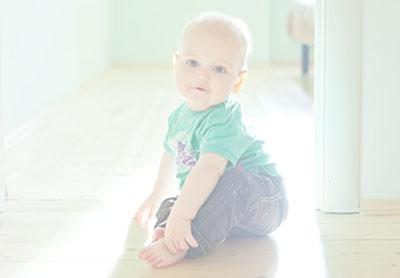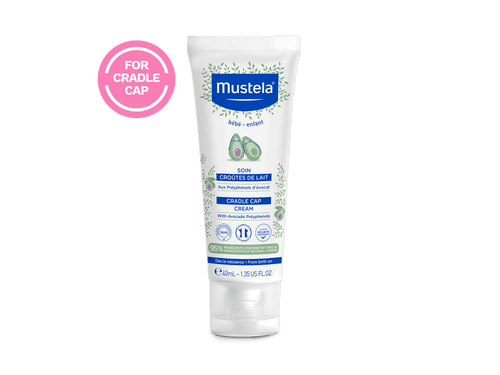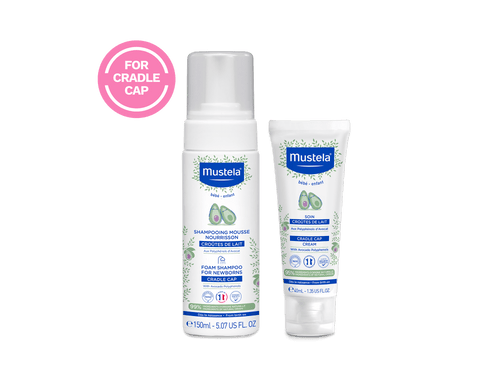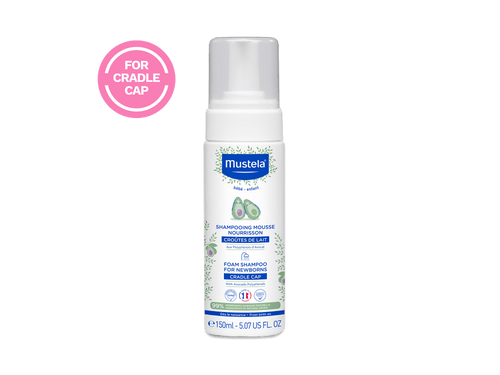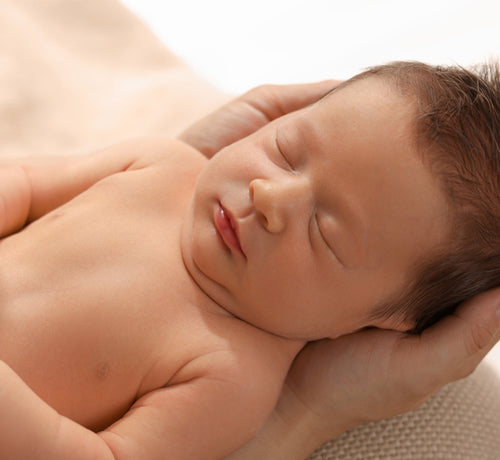You go to pick up your little one and notice a bald patch on the back of their head. While this discovery is certainly startling, baby hair loss is actually pretty common. So don't worry just yet — here's what you need to know about losing hair in infancy.
During the first few months of your baby’s life, it seems like they change every day. Some of those changes are exciting — gaining weight, smiling when they look at you, and holding their head up on their own, just to name a few.
Other changes, however, can be worrisome, such as:
- Cradle cap
- Baby acne
- Skin rashes
- Eczema
These issues often develop without warning and can have you wondering what’s going on.

Perhaps one of the most worrisome changes is baby hair loss. The night before, your baby seems fine. The next morning, though, you notice a small clump of hair in their crib and the small bald patch mentioned above. Is this a sign of a larger problem? Should you be concerned?
Before you rush to the pediatrician, let us assure you that baby hair loss is completely normal. Your baby is losing their hair for the same reason you lost some hair during your pregnancy (or will once your little one arrives): hormones.
But what exactly is baby hair loss, and why does it occur? What should concerned parents do if their baby starts to go bald? The experts at Mustela will answer those questions and put all your fears about baby hair loss to rest.
Table Of Contents
- What Is Baby Hair Loss And Why Does It Happen?
- Baby Hair Loss Is Normal
- How To Recognize Normal Baby Hair Loss
- Will Your Baby’s Hair Regrow?
- When Does Baby Hair Loss Occur?
- What To Do If Your Baby Starts To Lose Their Hair
- Mention Baby Hair Loss To Your Pediatrician If Necessary
What Is Baby Hair Loss And Why Does It Happen?

Before we get into the specifics of baby hair loss, it’s important to note that the scientific term for this condition is telogen effluvium. This term can be both deceiving and alarming because telogen effluvium can be used to refer to a wide variety of hair loss in babies, children, and adults.
But most likely, none of the serious causes listed for telogen effluvium — like physical or emotional stress, chronic illness, and anemia — are behind your baby’s hair loss.
Hair has a growth stage and a resting stage. During the resting stage, the hair remains in the follicle until new hair starts to grow.
As we get older, about 5-15% of hair on the scalp is typically in the resting phase at any one time, but stress, fever, or a hormonal change can cause a large number of hairs to stop growing all at once.
Because a newborn's hormone levels fluctuate significantly right after birth, it may cause them to lose the hair they were born with. Their body is processing out their mother’s hormones and replacing them with something more suitable for their new environment outside the womb.
Baby Hair Loss Is Normal
Whether your baby loses a few tufts of hair here and there or goes completely bald, it’s nothing to worry about.
The reason most adults immediately jump to the worst conclusion is because sudden hair loss (telogen effluvium) later on in life is usually a symptom of a larger problem. Again, that’s often not the case for infants.
The fluctuating hormones that are likely the trigger for hair loss are a natural part of the growth process.
How To Recognize Normal Baby Hair Loss
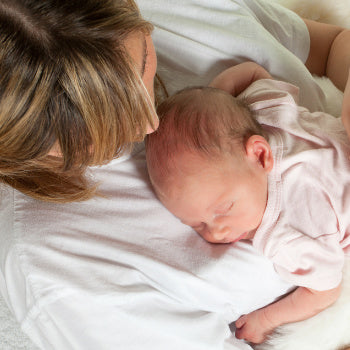
Normal baby hair loss will not bother your baby in any way, shape, or form. They won’t even feel it or know that it’s going on!
Here are the signs of natural baby hair loss:
- Hair in your little one’s crib, stroller, or any place where they rest their head
- Loose strands of hair in your hand after you caress your baby’s head
- Hair in the bath or on the towel you use to dry them off
- Hair leftover in a hat after you take it off (especially noticeable during the winter)
If these are the only signs you see, there’s no need to worry — your newborn is just going through a new stage in their development.
If your little one starts to act differently around the same time you notice the hair loss, visit your pediatrician just to be sure.
Will Your Baby’s Hair Regrow?
Yes, your little one’s hair will regrow, so, again, there’s no need to panic.
In some newborns, the process happens slowly so that losing hair and growing new hair happen at the same time. While you may notice hair in your hand or in their crib, you may not see a significant difference in the look of your little one’s hair.
In other babies, the process happens quickly, and your newborn may go completely bald in a matter of days.
Both situations are normal, and the hair will come back in the weeks and months to follow. Don’t be surprised, though, if the new hair looks different than the hair they were born with. It’s not uncommon for your baby’s locks to change completely after this initial hair loss.
When your little one’s hormone levels stabilize, their hair may be blonde even though it started out as brown. It may go from curly to straight or from thick to thin. The end result depends on your baby’s genes and the new hormones they produce as they grow.
When Does Baby Hair Loss Occur?
Most infants will lose some or all of their hair in the first six months after they’re born.
There’s no set schedule, so it could happen right away after they come home from the hospital, or it could hold off until they’re rolling from their back to their tummy and sitting up on their own.
Fortunately, most babies will regrow their hair completely by the time they turn one. Even if they start losing their hair at six months old, everything will likely be back to normal in another six months.
What To Do If Your Baby Starts To Lose Their Hair

Keep in mind that your baby is losing hair as a result of a natural process that’s occurring inside their body, which means that there’s very little you can do to prevent the situation.
You can, however, help to minimize it by following these simple suggestions.
1) Don’t Panic
Almost 10 times out of 10, your baby’s hair loss will be the result of the normal fluctuations in hormone levels that we mentioned before as their body metabolizes your hormones and replaces them with more appropriate, and much gentler, newborn hormones.
That said, there’s still a very small chance that their hair loss could be the result of some other cause. As soon as you notice that your baby’s hair is thinning, you should start to look for other symptoms as it’s often better to be overly cautious in situations like these.
2) Look For Other Symptoms
One of the biggest indicators that something more serious is happening with your baby is a change in behavior associated with the hair loss.
Is your little one sleeping less for no apparent reason? Are they refusing to eat foods they liked before? Are they acting strange?
These are not indicators in and of themselves (babies change the way they sleep, eat, and act all the time), but they can alert you to an underlying problem. Some symptoms to keep an eye out for include:
- Patchy bald spots with red, flaky scales
- Isolated smooth, round, totally bald areas
- Swelling of the tongue and around the eyes, coupled with cool, pale skin
- Increased thirst and urination
- Sluggishness
- Jitteriness
None of these symptoms indicate a life-threatening illness, but it’s important to consult a doctor for further advice if you observe them in your baby.
Note that hair loss can also be caused by external forces that have nothing to do with your baby’s hormones.
If you regularly put your baby’s hair in a ponytail (of any size or at any location on their head), the tightness of the ponytail may result in hair loss. Even excessive twirling or hair pulling (by your baby) can cause irregular patches to fall out.
3) Observe The Way Your Baby Sits And Sleeps

Another external factor that may contribute to your baby’s hair loss is the way they sit and sleep. When you start to pay attention, you may notice that your baby spends a lot of time in the same position.
For example, when they sleep, they turn their head to the right to look at the world outside the crib. Then, when they sit in their car seat, they turn their head to the right to look out the window.
Spending too much time in one position can put pressure on your little one’s skin, creating friction that may cause hair loss. If your baby usually sleeps with their head at one end of the crib, try putting them down with their head at the other end of the crib for a night or two.
If your baby experiences hair loss from friction, it may last for a while. But once they start sitting up and aren’t rubbing their heads on surfaces as much, their hair should start growing back.
4) Encourage Tummy Time

Every young baby should spend time on their tummy. Not only does this give the back of their head a rest and minimize hair loss, but it’s also essential for their overall health and physical development.
When a baby’s on their tummy, they have to work to lift their head, to turn their neck, to see mom and dad, and to interact with the world.
Ultimately, tummy time helps your baby learn to push up, roll over, sit up, crawl, and eventually stand — all important developmental milestones in your baby’s life.
You can start practicing tummy time right away after your baby’s born. Until they learn to move their head effectively on their own, keep an eye on your little one while they’re in this position. If they fall asleep, be sure to turn them over onto their back.
Keep in mind that tummy time should only take place when you can supervise. Never let your baby sleep on their tummy until they can roll themselves all the way over.
Instead, continue practicing safe sleep habits, even if you’re worried sleeping on their back is causing them to lose more hair.
5) Treat Your Baby’s Scalp Gently
Even though you can’t prevent hair loss altogether, you can minimize the effects by treating your baby’s scalp and hair gently.
Here are some simple suggestions:
- Avoid headbands
- Don’t tie braids or ponytails too tight
- Comb your baby’s hair with a soft baby brush
- Only comb hair once every other day
- Skip styling your baby’s hair
- Don’t dry their hair with a hairdryer
- Don’t put a hat or cap on their head if it’s hot outside
- Avoid hair care products with harsh chemicals
These tips only apply so long as your little one is losing their hair. After they stop losing their newborn hair and start growing their big-girl or big-boy hair, by all means, let them wear hats and headbands. Wash their hair as necessary and comb it when it gets out of hand.
These common activities won’t irritate their scalp — or make them lose more hair — once they’ve started the process of regrowth.
6) Don’t Wash Your Baby’s Hair Every Day

One of the best things you can do to minimize the effects of baby hair loss is to avoid washing your baby’s hair every day. Even a gentle washing and the light friction of your hands against their scalp can accelerate the hair loss.
When you do wash, use a baby-formulated shampoo, like Mustela’s Gentle Shampoo or Foam Shampoo For Newborns, and be extra gentle so you don’t stress the scalp and hair follicles even more.
Our gentle shampoos are made from 99% naturally derived ingredients so you don’t have to worry about using them on your baby’s delicate scalp.
7) Treat Cradle Cap
Cradle cap is a common condition that can cause your baby’s hair to fall out. It’s characterized by scaly patches on the scalp. When these patches come off, they can take hair with them. So, if you notice these flakes, be sure to treat their scalp right away to prevent further loss of hair.
To help clear up your baby’s scalp, wash their hair only with gentle shampoos. Avoid using anything with chemicals that can dry out their skin even more. In addition, use our Cradle Cap Cream to keep their head moisturized. This will help keep the dry scales from returning.
8) Accept Baby Hair Loss As Natural
Understand that even if you do everything on this list, your baby may still lose some or all of the hair they were born with. Again, don’t panic. The hair will come back with time.
The best thing you can do is accept your little one’s hair loss as a natural part of growing up. We suggest keeping some of the hair they lose in an envelope as a reminder of their first few months.
Just imagine how much fun it will be when they’re older to show them the straight blonde hair they were born with and compare it to the brown curly hair they have now.
Mention Baby Hair Loss To Your Pediatrician If Necessary
If you’re worried about your baby’s hair loss or if you notice any of the symptoms mentioned early in the article, talk to your pediatrician right away.
The doctor will either confirm that the problem is simply a result of hormones, or they’ll be able to let you know if it’s more serious. Either way, it will set your mind at ease and make you feel better. And that’s good for both you and your baby.
In the meantime, use our gentle Foam Shampoo for Newborns to take good care of the hair that’s left on your little one’s head. And remember, it won’t be long until they once again have a full head of hair.
For more helpful advice on pregnancy, parenting, and all things baby and mommy skincare related, visit MustelaUSA.com today.


